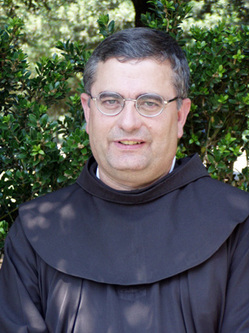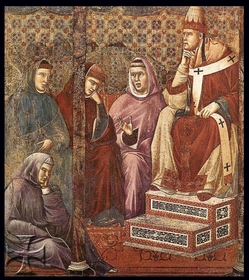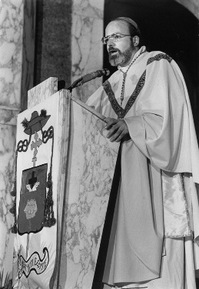 25 years ago Capuchin Father Sean Patrick O’Malley was ordained a bishop. Currently he’s the cardinal-archbishop of Boston but not before periods of episcopal ministry in the US Virgin Islands, Fall River, Palm Beach.
25 years ago Capuchin Father Sean Patrick O’Malley was ordained a bishop. Currently he’s the cardinal-archbishop of Boston but not before periods of episcopal ministry in the US Virgin Islands, Fall River, Palm Beach.
Category: Franciscans
Our Lady of the Angels of the Portiuncula
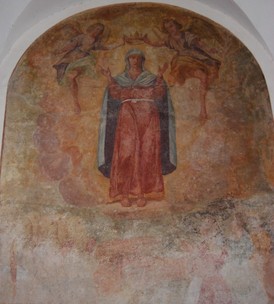 Today is the feast of Our Lady of the Angels of the Portiuncula, the Virgin under whose mantle Saint Francis of Assisiwas wrapped; Mary’s maternal protection made it possible for blessed Francis to experience an intentse Presence of the Lord and to receive his vocation to rebuild the Church. The Portiuncula is also the place where Francis knew first hand the experience of being sustained by the Angels. Likewise his intimate devotion to the Blessed Mother, under whose protection did he place himself to do the Lord’s work did this place become holy for the members of the Franciscan family and for the Church universal. As a place of pilgrimage, the holy Portiuncula is a poignant reminder of how important the encounter with Christ was for Saint Francis and how much the encounter ought to be pivotal for us today. Without meeting Christ, little makes sense. Saint Bonaventure had this to say about this devotion:
Today is the feast of Our Lady of the Angels of the Portiuncula, the Virgin under whose mantle Saint Francis of Assisiwas wrapped; Mary’s maternal protection made it possible for blessed Francis to experience an intentse Presence of the Lord and to receive his vocation to rebuild the Church. The Portiuncula is also the place where Francis knew first hand the experience of being sustained by the Angels. Likewise his intimate devotion to the Blessed Mother, under whose protection did he place himself to do the Lord’s work did this place become holy for the members of the Franciscan family and for the Church universal. As a place of pilgrimage, the holy Portiuncula is a poignant reminder of how important the encounter with Christ was for Saint Francis and how much the encounter ought to be pivotal for us today. Without meeting Christ, little makes sense. Saint Bonaventure had this to say about this devotion:
The Portiuncula was an old church dedicated to the Virgin Mother of God which was abandoned. Francis had great devotion to the Queen of the world and when he saw that the church was deserted, he began to live there constantly in order to repair it. He heard that the Angels often visited it, so that it was called Saint Mary of the Angels, and he decided to stay there permanently out of reverence for the angels and love for the Mother of Christ. This is also the place where St Clare took her vows and where Saint Francis died.
Consider the words of an early biographer of Saint Francis of Assisi:
From there he moved to another place, which is called the “Portiuncula,” where there stood a church of the Blessed Virgin Mother of God built in ancient times. At that time it was deserted and no one was taking care of it. When the holy man of God saw it so ruined, he was moved by piety because he had a warm devotion to the Mother of all good and he began to stay there continually. The restoration of that church took place in the third year of his conversion. At this time he wore a sort of hermit’s habit with a leather belt. He carried a staff in his hand and wore shoes. One day the gospel was being read in that church about how the Lord sent out his disciples to preach. The holy man of God, who was attending there, in order to understand better the words of the gospel, humbly begged the priest after celebrating the solemnities of the Mass to explain the gospel to him. The priest explained it all to him thoroughly line by line. When he heard that Christ’s disciples should not possess gold or silver or money, or carry on their journey a wallet or a sack, nor bread nor a staff, not to have shoes nor two tunics, but that they should preach the kingdom of God and penance, the holy man, Francis immediately exulted in the spirit of God. “This is what I want,” he said, “this is what I seek, this is what I desire with all my heart.” The holy father, overflowing with joy, hastened to implement the words of salvation, and did not delay before he devoutly began to put into effect what he heard. (From The Life of Saint Francis by Thomas of Celano)
Read about and perhaps seek The Portiuncula Indulgence if you visit any Franciscan Church and observe the conditions for receiving the indulgence.
The Holy Father made reference to this in his Sunday Angelus address:
… today is the feast of the “Pardon of Assisi,” which St. Francis obtained from Pope Honorious III in the year 1216, after having a vision while he was praying in the little church of the Portiuncula. Jesus appeared to him in his glory, with the Virgin Mary on his right and surrounded by many Angels. They asked him to express a wish and Francis implored a “full and generous pardon” for all those who would visit that church who “repented and confessed their sins”. Having received papal approval, the Saint did not wait for any written document but hastened to Assisi and when he reached the Portiuncula announced the good news: “Friends, the Lord wants to have us all in Heaven!”. Since then, from noon on 1 August to midnight on the second, it has been possible to obtain, on the usual conditions, a Plenary Indulgence, also for the dead, on visiting a parish church or a Franciscan one.
A note about indulgences, which are often misunderstood. Indulgences are not forgiveness for sin but forgiveness for temporal punishment due to sin; that the residual effects of sin are forgiven.
Also, visit The Shrine website (read in 3 languages)
On this feast we pray
August Queen of Heaven, sovereign queen of Angels, you who at the beginning received from God the power and the mission to crush the head of Satan, we beseech you humbly, send your holy legions so that, on your orders and by your power, they will track down demons, fight them everywhere, curb their audacity and plunge them into the hell.
Who can be compared to God? Oh good and tender Mother, you will always be our love and our hope. Oh divine Mother, send the Holy Angels and Archangels to defend me and to keep the cruel enemy far from me. Holy Angels and Archangels defend us, protect us. Amen.
Capuchins reflect on their work in the Amazon
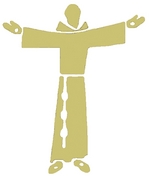 The Capuchins in Italy are taking time to reflect on
The Capuchins in Italy are taking time to reflect on
the greatest God-given gift they’ve received: work of 100 years among the native Brasilian
peoples. What really struck me was the Provincial’s comment: “And we truly lived it as
a gift: participating in His mission, that is to say, the mission of Jesus
Christ.”
Jesuits suppressed: the 236th anniv
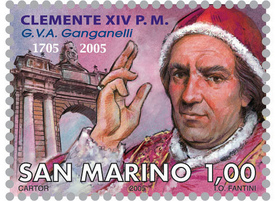 Today is the 236th anniversary of the promulgation of Dominus ac Redemptor, the papal bull of Pope Clement XIV (a Conventual Franciscan) suppressing the Society of Jesus (the Jesuits). In this bull the pope dissolved the Society without condemning it because it is said that he did revere many of its members. Hence, the suppression had nothing to do with enmity (Franciscans vs. Jesuits) as much as it had to do with the significant criticism the Society faced and the likely realization of the threat of Church schism if the pope didn’t do something with the Jesuits. Faced with the pressure of a fragmented Church, Clement did what he had to do. By the time of this unusual papal intervention, the Jesuits were expelled from Brasil, Portugal, France, Spain and Parma.
Today is the 236th anniversary of the promulgation of Dominus ac Redemptor, the papal bull of Pope Clement XIV (a Conventual Franciscan) suppressing the Society of Jesus (the Jesuits). In this bull the pope dissolved the Society without condemning it because it is said that he did revere many of its members. Hence, the suppression had nothing to do with enmity (Franciscans vs. Jesuits) as much as it had to do with the significant criticism the Society faced and the likely realization of the threat of Church schism if the pope didn’t do something with the Jesuits. Faced with the pressure of a fragmented Church, Clement did what he had to do. By the time of this unusual papal intervention, the Jesuits were expelled from Brasil, Portugal, France, Spain and Parma.
Our Lady of the Atonement
Father Paul Wattson, the founder with Mother Lurana White, of the Franciscan Friars and Sisters of the Atonement, gave hundreds of sermons, conducted numerous retreats, delivered many radio addresses and wrote extensively in four magazines: The Pulpit of the Cross, The Lamp, The Candle and The Antidote.
The following piece is Father Wattson’s commentary on the feast of Our Lady of the Atonement. This Marian feast was approved by the Holy See in 1946 but it was first observed in July 1901.
The theological datum on atonement and therefore mercy, is near-and-dear to the heart of the Church and indeed to all Christians, so today’s feast is apt. Let us pray for each other!
I am writing this letter on the day which we are accustomed to observe at Graymoor in special honor of Our Lady of the Atonement. This particular name of Our Blessed Mother is very dear to us and we believe it is dear to Our Lady herself. We hold it as among the most treasured and sacred traditions of our Institute that it was the Blessed Virgin who first taught us to call her by that name and there are cogent reasons why she should give this title a favorite place among the many by which she is invoked.
First among these reasons must be her own devotion to the mystery of the Atonement, for it was by the death of her son on the Cross, which cost him the last drop of his blood and made her preeminently the mother of sorrows, that the wall of division between God and man was broken down and both were made one (Ephesians 2:14), through Christ’s atoning sacrifice.
As the Blessed Virgin is inseparably associated with our divine redeemer in the mystery of his incarnation, so is she closely associated with him in the great act of the atonement. Thus, is she always represented in the Gospel and in the liturgy and thought of the Catholic Church as standing by the cross, when Christ was crucified there.
There is a second reason, hardly less weighty than the first, why the title, Our Lady of the Atonement, should powerfully appeal to the mother of God. It was through the Incarnation she become the mother of Christ, but through the atonement she became the new Eve and the mother of all the regenerate, who being redeemed by the precious blood are predestined to eternal life as the adopted sons of God and heirs of the Kingdom of Heaven. The third time Our Lord spoke upon the cross it was to emphasize this phase of the Atonement, when he said to his mother: “Woman, behold your son,” and to St. John, “Son, behold your mother.” [John 19:26-27] Thus by virtue of the atonement Mary is the mother of all who live through Christ. Can anyone therefore possibly conceive the depth of significance this title “Our Lady of the Atonement” must possess for Our Blessed Mother herself?
But someone will ask, if so highly esteemed, why should it be kept hidden for nineteen hundred years, to be made known to the faithful in the twentieth century? Is it not the custom even of earthly mothers to preserve the choicest
fruits in the summer time and hide them away under lock and key, to bring them forth to their children’s delight in the depth of winter and did not the master of the wedding feast say to the bridegroom at Cana,
|
Every man at first brings forth good wine and when men have well drunk, then that which is worse. But you have kept the good wine until now. [John 2:10] |
|
“My ways are not your ways,” [Isaiah 55:8] says the Lord of Hosts. (The Lamp, August 1919, pp.503-4) |
Franciscans re-elect Friar Jose Rodriguez Carballo as 119th successor to Saint Francis
ASSISI, Italy (CNS) — Spanish Father Jose Rodriguez
Carballo was re-elected to head the Franciscan order during a general chapter
May 24-June 20 in Assisi, Italy, the birthplace of St. Francis. Father
Carballo, 55, was elected to a second six-year term as minister general of the
Order of Friars Minor June 4. Some 152 representatives of the order reconfirmed
the Spanish friar during the Assisi meeting as the leader of the 15,000
Franciscans who live in 113 countries. Father Carballo is the 119th successor of
St. Francis and will lead the Order of the Friars Minor until 2015. The
delegates will celebrate the 800th anniversary of the founding of their order
June 9. Father Carballo told reporters at the end of May that during the
general chapter the delegates were looking at how well the order has met the
priorities set in 2003 for deepening spirituality, improving fraternal life and
living as poor among the poor and in solidarity with all those in need. Second,
he said, they would try to find new ways to meet the challenge of being
missionaries in the modern world.
The Franciscan Life…a lived reality of the heart & Will of God
 The General Chapter of the Franciscan Order is meeting right now in Assisi. This is a privileged time of fraternity because it gives the brotherhood to review the past 800 years and sets in motion a vision for living that follows more closely in the footsteps of Saint Francis and Christ crucified and risen. The friars produced a terrific video that’s hopeful and powerful. You can view “I dream of a Franciscan Life” here.
The General Chapter of the Franciscan Order is meeting right now in Assisi. This is a privileged time of fraternity because it gives the brotherhood to review the past 800 years and sets in motion a vision for living that follows more closely in the footsteps of Saint Francis and Christ crucified and risen. The friars produced a terrific video that’s hopeful and powerful. You can view “I dream of a Franciscan Life” here.
Following the Lord according to Saint Francis (& the Friars of the Renewal)
Saint Francis’ Way in the World: the encounter with Christ
 Capuchin Father Raniero Cantalamessa, preacher of the Pontifical Household, spoke to the participants in the Chapter of the Mats in Assisi, on the occasion of the eighth centenary of the Church’s oral approval of the life proposed by Saint Francis of Assisi.
Capuchin Father Raniero Cantalamessa, preacher of the Pontifical Household, spoke to the participants in the Chapter of the Mats in Assisi, on the occasion of the eighth centenary of the Church’s oral approval of the life proposed by Saint Francis of Assisi.
Friar Raniero gives the reader a terrific sense of the Franciscan charism through the centuries but resting on the one and only central aspect of Franciscan life: Christ is everything. His point is that believe that Francis is really unimportant in comparison to following Christ because our salvation comes not from following Francis but Christ crucified and risen. That is, Francis kept his focus on Christ and Christ alone –and we ought to do the same. Hence what we ought to do is to closely follow Christ with the assistance of Saint Francis (and the Franciscan saints). As Francis kept his eyes on Christ so ought we to do the same.
The text of his remarks is found here.
Pope to Franciscans: define yourselves by the beauty of the Gospel
On Saturday, April 18, the Holy Father received various members of the Franciscan family at Castel Gandolfo to observe the 800th anniversary of the ecclesial recognition of the Charism of Saint Francis of Assisi. His remarkable talk is presented here with my emphases. As always the Pope gently and clearly speaks a word of truth and hope.
With great joy I welcome you all at this happy and historic occasion that has gathered you all together: the eighth centenary of the approval of the “protoregola” [monastic rule] of St. Francis by Pope Innocent III. Eight hundred years have passed, and those dozen friars have become a multitude, scattered all over the world and now here, by you, worthily represented. In recent days you have gathered in Assisi for what you wanted to call the “Chapter of Mats” to recall your origins. And at the end of this extraordinary experience you have come together with the “Signor Papa” [Lord Pope], as your seraphic founder would say. I greet you all with affection: the Friars Minor of the three branches, guided by the respective Ministers General, among whom I thank Father José Rodriguez Carballo for his kind words, the members of the Third Order, with their Minister General; the Franciscan women religious and members of the Franciscan secular institutes, and knowing them spiritually present, the Poor Clares, which constitute the “second order.”
I am pleased to welcome some Franciscan bishops, and in particular I greet the bishop of Assisi, Archbishop Domenico Sorrentino, who represents the Church of Assisi, the home of Francis and Clare, and spiritually, of all the Franciscans. We know how important it was for Francis, the link with the bishop of Assisi at the time, Guido, who acknowledged his charisma and supported it. It was Guido who presented Francis to Cardinal Giovanni of St. Paul, who then introduced him to the Pope and encouraged the adoption of the Rule. Charism and institution are always complementary for the edification of the Church.
What should I tell you, dear friends? First of all I would like to join you in giving thanks to God for the path that he has marked out for you, filling you with his benefits. And as Pastor of the Church, I want to thank him for the precious gift that you are for the entire Christian people. From the small stream that flowed from the foot of Mount Subasio, it has formed a great river, which has made a significant contribution to the universal spread of the Gospel. It
all began from the conversion of Francis, who, following the example of Jesus “emptied himself” (cf. Phil 2:7) and, by marrying Lady Poverty, became a witness and herald of the Father who is in heaven. To the “Poverello” [little poor man], one can apply literally some expressions that the apostle Paul uses to refer to himself and which I like to remember in this Pauline Year: “I have been crucified with Christ and it is no longer I who live, but Christ who lives in me. And this life, I live in the flesh, I live by faith of the Son of God who has loved me and given himself for me” (Gal. 2:19-20). And again: “From now on let no one bother me: for I wear the marks of Jesus on my body” (Gal 6:17).
![]() Francis reflects perfectly the footsteps of Paul and in truth can say with him: “For me, to live is Christ” (Phil 1:21). He has experienced the power of divine grace and he is as one who has died and risen. All his previous wealth, any source of pride and security, everything becomes a “loss” from the moment of encounter with the crucified and risen Jesus (cf. Phil 3:7-11). The leaving of everything at that point becomes almost necessary to express the abundance of the gift received. A gift so great as to require a total detachment, which itself isn’t enough; it requires a entire life lived “according to the form of the holy Gospel” (2 Tests, 14: the Franciscan Sources, 116).
Francis reflects perfectly the footsteps of Paul and in truth can say with him: “For me, to live is Christ” (Phil 1:21). He has experienced the power of divine grace and he is as one who has died and risen. All his previous wealth, any source of pride and security, everything becomes a “loss” from the moment of encounter with the crucified and risen Jesus (cf. Phil 3:7-11). The leaving of everything at that point becomes almost necessary to express the abundance of the gift received. A gift so great as to require a total detachment, which itself isn’t enough; it requires a entire life lived “according to the form of the holy Gospel” (2 Tests, 14: the Franciscan Sources, 116).
And here we come to the point that surely lies at the heart of our meeting. I would summarize it as follows: the Gospel as a rule of life. “The Rule and life of the Friars Minor is this, to observe the Holy Gospel of our Lord Jesus Christ:” this is what Francis writes at the beginning of his Rule (Rb I, 1: FF, 75). He defined himself entirely in the light of the Gospel. This is his charm. This is his enduring relevance. Thomas of Celano relates that the Poverello “always held himself in the heart of Jesus. Jesus on the lips, Jesus in his ears, Jesus is his eyes, Jesus in his hands, Jesus in all the other members […] In fact finding himself often traveling and meditating or singing about Jesus, he would forget he was traveling and would stop to invite all creatures to praise Jesus” (1 Cel., II, 9, 115: FF115). So the Poverello has become a living gospel, able to attract to Christ men and women of all ages, especially young people, who prefer radical idealism to half-measures. The Bishop of Assisi, Guido, and then Pope Innocent III recognized in the proposal of Francis and his companions the authenticity of the Gospel, and knew how to encourage their commitment for the good of the Church.
Here is a spontaneous reflection: Francis could have also not gone to the Pope. Many religious groups and movements were forming during that time, and some of them were opposed to the Church as an institution, or at least didn’t seek the Churches’ approval. Certainly a polemical attitude towards the hierarchy would have won Francis many followers. Instead, he immediately thought to put his journey and that of his companions into the hands of the Bishop of Rome, the Successor of Peter. This fact reveals his true ecclesial spirit. The little “we” that had started with his first friars he conceived from the outset inside
 the context of the great “we” of the one and universal Church. And the Pope recognized and appreciated this. The Pope, in fact, on his part, could have not approved the project of the life of Francis. Indeed, we can well imagine that among the collaborators of Innocent III, some counseled him to that effect, perhaps fearing that his group of monks would end up resembling other heretical groups and pauperisms of the time. Instead the Roman Pontiff, well informed by the Bishop of Assisi and Cardinal Giovanni of St. Paul, was able to discern the initiative of the Holy Spirit and welcomed, blessed and encouraged the nascent community of “Friars Minor.”
the context of the great “we” of the one and universal Church. And the Pope recognized and appreciated this. The Pope, in fact, on his part, could have not approved the project of the life of Francis. Indeed, we can well imagine that among the collaborators of Innocent III, some counseled him to that effect, perhaps fearing that his group of monks would end up resembling other heretical groups and pauperisms of the time. Instead the Roman Pontiff, well informed by the Bishop of Assisi and Cardinal Giovanni of St. Paul, was able to discern the initiative of the Holy Spirit and welcomed, blessed and encouraged the nascent community of “Friars Minor.”
Dear brothers and sisters, eight centuries have passed, and now you have wanted to renew this gesture of your founder. You are all sons and heirs of those origins, of that “good seed” which was Francis, who was conformed to the “grain of wheat” which is the Lord Jesus, died and risen to bring forth much fruit (cf. Jn 12:24). The saints propose anew the fruitfulness of Christ. As Francis and Clare of Assisi, you also commit yourselves to follow the same
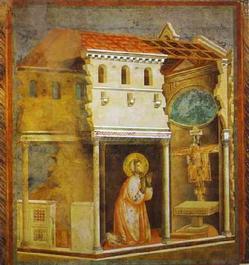 logic: to lose your lives for Jesus and the Gospel, to save them and make them abundantly fruitful. While you praise and thank the Lord who has called you to be part of such a great and beautiful family, stay attentive to what the Spirit says to it today, in each of its components, to continue to proclaim with passion the Kingdom of God, the footsteps of your seraphic father. Every brother and every sister should keep always a contemplative mood, happy and simple; always begin from Christ, as Francis set out from the gaze of the Crucifix of San Damiano and from the meeting with the leper, to see the face of Christ in our brothers and sisters who suffer and bring to all his peace. Be witnesses to the “beauty” of God, which Francis was able to sing contemplating the wonders of creation, and that made him exclaim to the Most High: “You are beauty!” (Praises of God Most High, 4.6: FF 261).
logic: to lose your lives for Jesus and the Gospel, to save them and make them abundantly fruitful. While you praise and thank the Lord who has called you to be part of such a great and beautiful family, stay attentive to what the Spirit says to it today, in each of its components, to continue to proclaim with passion the Kingdom of God, the footsteps of your seraphic father. Every brother and every sister should keep always a contemplative mood, happy and simple; always begin from Christ, as Francis set out from the gaze of the Crucifix of San Damiano and from the meeting with the leper, to see the face of Christ in our brothers and sisters who suffer and bring to all his peace. Be witnesses to the “beauty” of God, which Francis was able to sing contemplating the wonders of creation, and that made him exclaim to the Most High: “You are beauty!” (Praises of God Most High, 4.6: FF 261).
Dear friends, the last word I would like to leave with you is the same that the risen Jesus gave to his disciples: “Go!” (cf. Mt 28:19, Mk 16:15). Go and continue to “repair the house” of the Lord Jesus Christ, his Church. In recent days, the earthquake that struck the Abruzzo region has severely damaged many churches, and you from Assisi know what this means. But there is another “ruin” that is far more serious: that of people and communities! Like Francis, always start with yourselves. We are the first house that God wants to restore. If you are always able to renew yourselves in the spirit of the Gospel, you will continue to assist the pastors of the Church to make more and more beautiful the Church’s face, that of the bride of Christ. The Pope, now the same as then, expects this of you. Thank you for coming! Now go and bring to all the peace and love of Christ the Savior. May Mary Immaculate, “Virgin made Church” (cf. Greetings to the Blessed Virgin Mary, 1 FF, 259), accompany you always. And may my Apostolic Blessing, which I cordially impart to all of you here present, and the entire Franciscan family, support you as well.
Benedictus PP. XVI
See the video clip on the Pope-Franciscan visit

